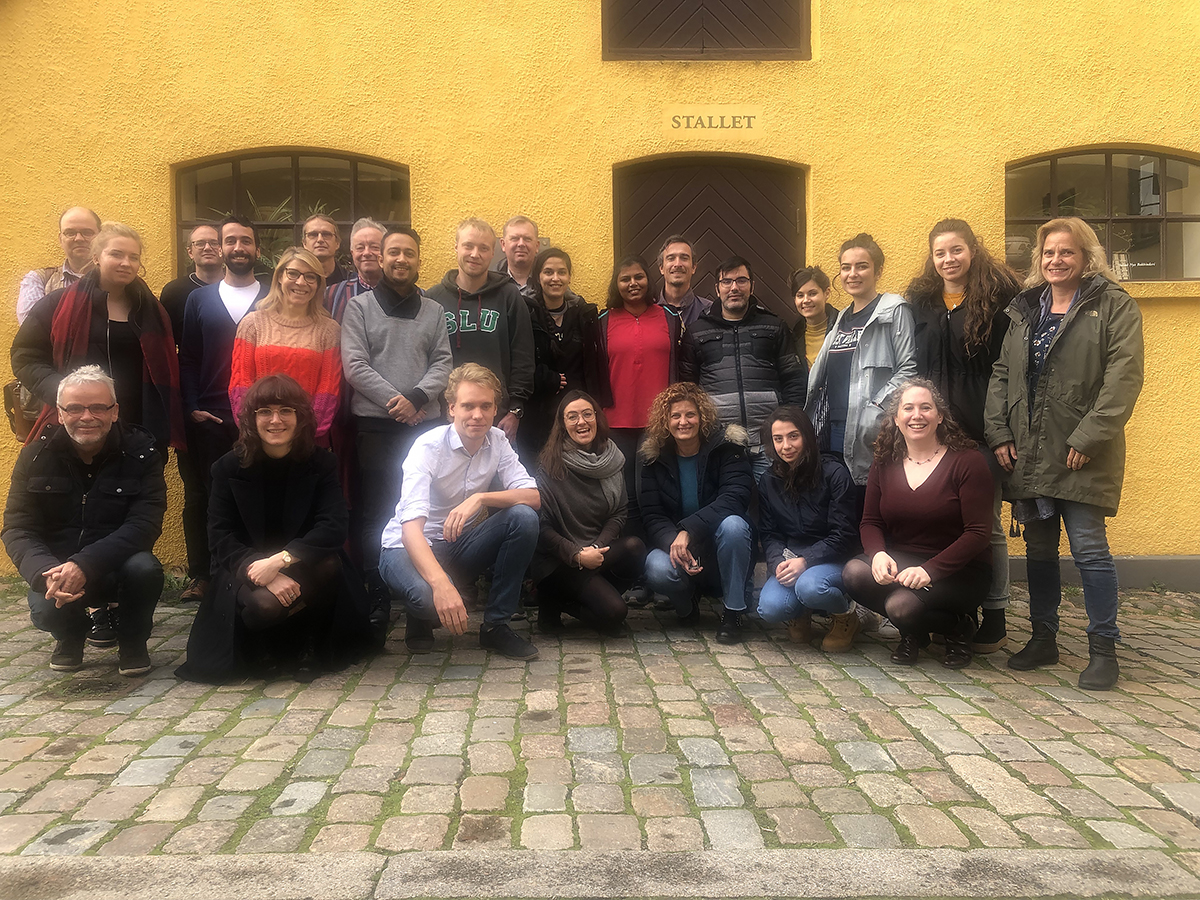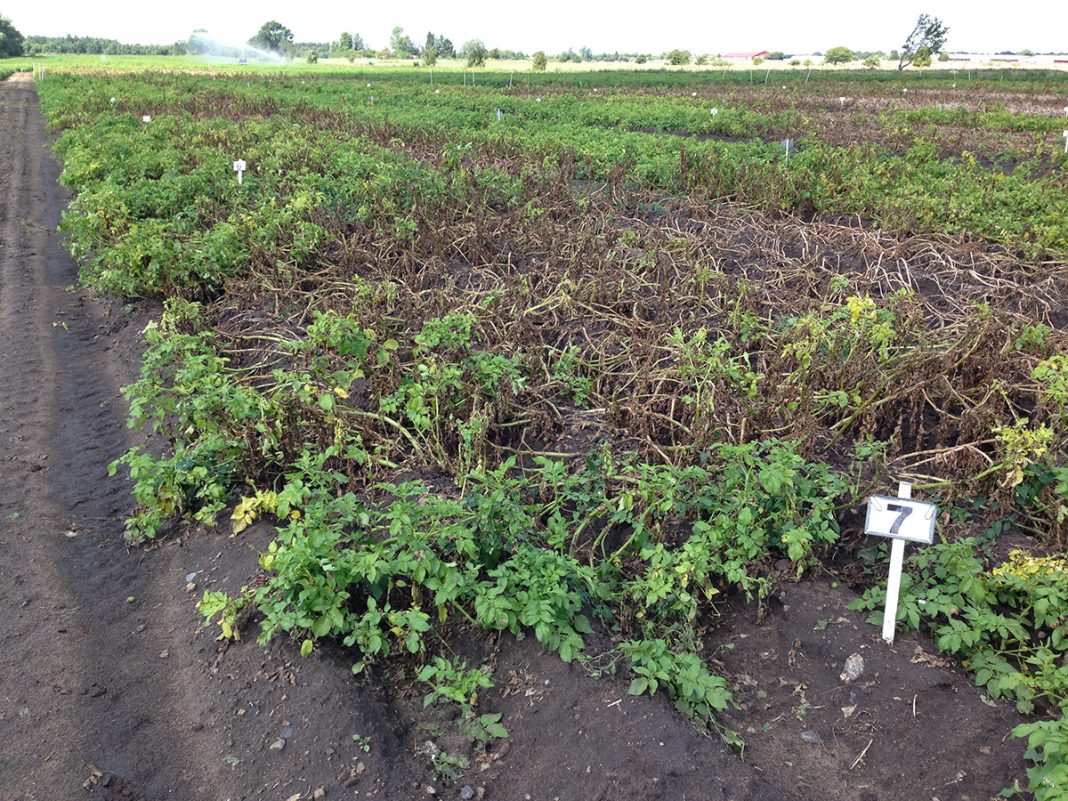Professor Laura Grenville-Briggs shares her stance on working together to counter the threat of oomycete diseases, focussing on trans-sectoral approaches to support sustainable plant and crop production systems in Europe
Oomycetes, microbes that superficially resemble fungi, are devastating pathogens affecting a wide range of plants and animals. Oomycete diseases in our agriculture, horticulture and aquaculture production systems as well as natural or managed ecosystems are a major threat to food security, environmental sustainability and economic stability. What is more, under current climate change predictions, oomycete diseases are predicted to spread polewards1 and with more unpredictable weather patterns are likely to be more disruptive in the future.
These diseases could, therefore, be a significant barrier to meeting objectives, such as the European Green Deal and the Farm2Fork strategy. For example, potato late blight is managed in conventional cropping systems with multiple fungicide applications. In Europe alone, more than 2 million tonnes of pesticides are applied annually in potato, largely to control late blight2.
How can the scientific research community support efforts to manage, mitigate and minimise these threats? Within the PROTECTA project, funded through Horizon 2020 EU-MSCA-ITN-2017 grant agreement number, 766048, we believe the pathways to achieve this are through training the next generation of researchers in scientific interdisciplinarity and trans-sectoral innovations.
A step back in time: Why are plant pathologists so fascinated with oomycetes?
Oomycetes have similar morphological characteristics to fungi and occupy the same ecological niches. The most well-known oomycete is Phytophthora infestans, the causal agent of potato and tomato late blight. This disease has a long history intertwined with our own; it is one of the plant diseases with the greatest impact on humanity. It is notorious as the biological cause of the Irish, and later European, Potato Famine in the 1840s which resulted in the deaths of more than 1 million people and the emigration of 1 million more.

The threat continues today…
As we have seen, sadly, during the recent coronavirus pandemic, the tragedies of widespread loss of life bring out the steely determination of the human character; a determination to understand, tame or destroy diseases that threaten our way of life. And so it has been with potato late blight and the oomycetes. The horror of the European Potato Famine and several severe epidemics in the years since, birthed the discipline of plant pathology and inspired generations of plant pathologists eager to understand and control these diseases.
Oomycetes like P. infestans are highly adaptable and are constantly evolving to overcome host resistance. Indeed, although P. infestans has a long history as a crop pathogen, it is, even today, still classed as a (re)emerging pathogen3. This is because late blight is continually spreading as we expand the frontiers of potato production and global populations of the pathogen are constantly fluctuating. This means we rely on repeated synthetic pesticide usage; potato late blight currently accounts for 7% of all pesticides used in the EU2 and comes with a global cost of upwards of €5 billion annually4.
In the face of such devastating diseases, how can we protect our crops sustainably?
Despite decades of research, there are still many unanswered questions about the biology of oomycete diseases and their control. We need to train the next generation of scientists to take up these questions with modern tools across molecular biology, genetics, ecology, evolutionary biology, plant breeding and the applied sciences. At PROTECTA, we do exactly this. We work across four scientific work packages, from bioinformatic and biochemical approaches to characterising oomycete-host interactions, to new breeding and translational approaches for disease control and finally, by studying oomycete ecology, diversity and management. The goal is to develop and evaluate strategies to control these diseases.
Our early-stage researchers are mentored in their doctoral studies by co-tutelage teams comprising industry and academic scientists from the different sectors most affected by oomycete diseases. It is rare to encounter forest ecologists discussing their data with biochemists or fish vets. But interdisciplinary and trans-sectoral approaches, such as these, are needed to spark innovation and creativity in our scientific problem-solving. PROTECTA provides an environment for just that.

Although the project is still ongoing, we have already made key discoveries that deepen our knowledge of oomycete-host interactions and management. We helped identify pathogen-mediated stomatal opening as a previously overlooked pathogenicity strategy used by oomycetes5 and uncovered the mechanism of activation of a specific plant immune response to P. infestans6. We have also catalogued,7 and pinpointed a specific mechanism of,8 pathogenicity determinants in the legume pathogen Aphanomyces euteiches. The project has also identified new frontiers for oomycete pathogens, such as the recent discovery of the tree-pathogenic oomycete Pythium kashmirense in the UK9.
To shape effective policies to protect against invasive oomycetes and the movement of diseases under climate change, new scientific data need to be gathered and reviewed. We have done this in a trans-sectoral way in PROTECTA, by gathering current practice and exploring new possibilities to control the spread of oomycetes in both terrestrial and aquatic production systems within an EU context10.
Some oomycete species parasitize fungi and other oomycetes. These so-called mycoparasites have the potential to unlock the keys to the control of plant diseases. For example, we can develop these organisms as biological control agents to deploy in field or greenhouse settings.
However, the development of such approaches is highly laborious, expensive and hindered by complex legislation (as our ESRs recently reviewed11). However, even without such direct practical applications, if we can unravel the complex mechanisms behind oomycete mycoparasitism, as we have begun to do in PROTECTA12, we can use this knowledge to develop sustainable tools that could provide durable control of oomycete pathogens and valuable new targets to enhance resistance breeding programmes.
References
- Bebber D, Ramotowski M, Gurr S. Crop pests and pathogens move polewards in a warming world. Nature Climate Change 2013, 3: 985-988.
- EUROSTAT ec.europa.eu/eurostat 2021.
- Fry W, Birch P, Judelson H, Grunwald N, Danies G, Everts K, Gevens A, Gugino B, Johnson D, Johnson S, McGrath M, Myers K, Ristaino J, Roberts P, Secor G, Smart C. Five Reasons to consider Phytophthora infestans a reemerging pathogen. Phytopathology 2015, 105:966-981.
- Haverkort A, Boonekamp P, Hutten R, Jacobsen E, Lotz L, Kessel G, Visser E, van der Vossen E. Societal costs of late blight in potato and prospects of durable resistance through cisgenic modification. Potato Research 2008, 51:47-57.
- Yang L, Liu H, Wang Y, Seematti J, Grenville-Briggs L, Wang Z, Zhan J. Pathogen-mediated stomatal opening: A previously overlooked pathogenicity strategy in the oomycete pathogen Phytophthora infestans. Frontiers in Plant Science 2021, 12.
- Paulus J, Kourelis J, Ramasubramanian S, Homma F, Godson A, Hörger A, Hong T, Krahn D, Ossorio-Carballo L, Wang S, Win J, Smoker M, Kamoun S, Dong S, van der Hoorn R. PNAS 2020, 117:29.
- Kiseliev A, San Clemente H, Camborde L, Dumas B, Galun E. A comprehensive assessment of the secretome responsible for host adaptation of the legume root pathogen Aphanomyces euteiches. J. Fungi 2022, 8:88.
- Camborde L, Kiselev A, Pel M, Le Ru A, Jauneau A, Pouzet C, Dumas B, Gaulin E. An oomycete effector targets a plant RNA helicase involved in root development and defence. New Phytologist 2022, 233: 2232-2248.
- Benavent-Celma C, Peurtolas A, McLaggan D, van West P, Woodward S. Pathogenicity and host range of Pythium kashmirense- A soil-borne oomycete recently discovered in the UK. J. Fungi 2021, 7:479.
- Benavent-Celma C, Lopez-Garcia N, Ruba T, Scislak M, Street-Jones D, van West P, Woodward S, Witzell J. Current practices and emerging possibilities for reducing the spread of oomycete pathogens in terrestrial and aquatic production systems in the European Union. Fungal Biology Reviews 2021.
- Hashemi M, Tabet D, Sandroni M, Benavent-Celma C, Seematti J, Andersen C, Grenville-Briggs L. The hunt for sustainable biocontrol of oomycete plant pathogens, a case study of Phytophthora infestans. Fungal Biology Reviews 2021.
- Liang D, Andersen C, Vetukuri R, Dou D, Grenville-Briggs L. Horizontal gene transfer and tandem duplication shape the unique cazyme complement of the mycoparasitic oomycetes Pythium oligandrum and Pythium periplocum. Frontiers in Microbiology 2020, 11:581698.

PROTECTA has received funding from the European Union’s HORIZON 2020 Research programme under the Grant Agreement no. 766048.

This work is licensed under Creative Commons Attribution-NonCommercial-NoDerivatives 4.0 International.



keep me posted
thank you